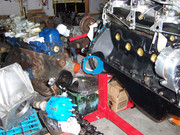DON
Well-known member
I just thought I would start this thread for all the guys who are going to rebuild an engine for the first time. Some things might seem obvious, but are worth mentioning to avoid a potential disaster. Add what you have learned the hard way 
I will start with: don’t use an engine stand with the base shaped like a T, and three wheels. Use the ones that have a base shaped like an H, 4 wheels. I had my engine, with head on, and had the cylinders oriented sideways, gave an ever so slight push to move the L shaped stand and disaster, it tipped over!! I think being an inline, there is not the counter weight of a second bank of cylinders that v8 have and the weight just gets too offset . I modified mine by adding angle iron and two new wheels. ( cheap on Amazon). I could only get 1/8 in angle iron and had to add the braces, a little more flex than I was comfortable with. Use quarter inch
. I modified mine by adding angle iron and two new wheels. ( cheap on Amazon). I could only get 1/8 in angle iron and had to add the braces, a little more flex than I was comfortable with. Use quarter inch 
I will start with: don’t use an engine stand with the base shaped like a T, and three wheels. Use the ones that have a base shaped like an H, 4 wheels. I had my engine, with head on, and had the cylinders oriented sideways, gave an ever so slight push to move the L shaped stand and disaster, it tipped over!! I think being an inline, there is not the counter weight of a second bank of cylinders that v8 have and the weight just gets too offset




